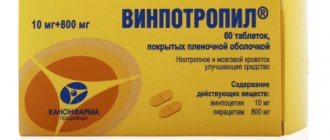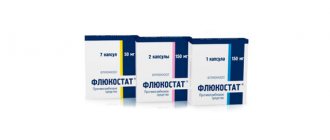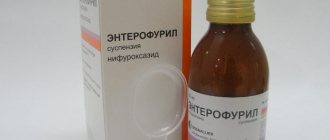Pharmacy shelves are simply bursting with a huge number of medications. For almost every disease, a pharmacist can offer you several types of medications, which not only have different therapeutic effects, but are also available in different forms. Brain diseases and vascular problems are quite common nowadays. There are many drugs to get rid of these ailments, one of them is Cerepro. Reviews from doctors about it are quite favorable; let’s get acquainted with its effects on the body and contraindications for use.
Composition and release form
The drug Cerepro is a centrally acting cholinomimetic intended for oral administration in a full course. The oblong red capsule with a gelatin shell contains a colorless oily liquid with a concentration of 400 mg of the active substance. Blisters are packed in 10 or 14 pcs. One cardboard package contains 1 blister and instructions for use. The second form of release is a solution for injection. 1 package contains 3, 5 or 10 ampoules. Features of the chemical composition:
| Release form | Active ingredient | Excipients |
| capsules | glycerylphosphorylcholine hydrate (0.4 g) | methylparaben, gelatin, propylparaben, glycerin, water for injection, sorbitol, red iron oxide, titanium dioxide |
| solution | glycerylphosphorylcholine hydrate (1000 mg) | water for injections |
pharmachologic effect
The choline component is a precursor to acetylcholine, a brain neurotransmitter. When entering the body, the mediator improves metabolic processes, increases the intensity of blood flow in brain cells and the plasticity of neural membranes. When choline is metabolized, glycerophosphate is formed, which is necessary for the synthesis of phosphatidylcholine. This component, penetrating into the organs of the central nervous system, increases the concentration of acetylcholine with a subsequent stimulating effect , and has a positive effect on memory function, which is reduced due to age-related changes.
The active substance of the drug does not cause mutagenic processes in cells, does not suppress reproductive function, and maintains intracranial pressure in the vessels of the brain at an optimal level. When a single dose is consumed, choline is rapidly absorbed from the gastrointestinal tract with a bioavailability of 80%. After entering the bloodstream, Cerepro is evenly distributed in tissues, penetrates the blood-brain barrier into the structures of the central nervous system, where it has a therapeutic effect. After metabolism, choline is excreted by the lungs with exhaled air and the kidneys with urine.
Special instructions and precautions
In general, Cerepro is well tolerated by the body, so there is no need to exercise extreme caution. The medication does not affect the speed of psychomotor reactions, so the patient is not limited in driving and work that requires concentration.
If nausea occurs, it is recommended to reduce the dose.
Drug interactions
Cerepro combines well with any other medications; the specifics of its interaction are not described by the manufacturer.
Use during pregnancy and lactation
Despite the fact that Cerepro does not affect the fetal development of the baby, it should not be used during pregnancy. Breastfeeding women should also refuse the medication. If treatment with this particular drug is necessary, breastfeeding will have to be stopped.
Prescription for children
The drug is not used in pediatrics. However, sometimes doctors can prescribe it; this requires special indications, and the patient must be under strict medical supervision.
Indications for use of Cerepro
For brain lesions accompanied by impaired nutrition of nervous system cells, doctors prescribe the drug Cerepro. The instructions indicate medical indications:
- consequences of traumatic brain injury;
- senile pseudomelancholia;
- ischemic and hemorrhagic strokes;
- post-stroke condition of the acute stage;
- encephalopathy;
- dementia;
- cerebrovascular disease;
- acute period after a stroke;
- cerebrovascular insufficiency;
- intracranial injuries and their consequences;
- state of demoralization, apathy;
- cognitive disorders;
- disorientation.
Pharmacological effects of the drug
The active substance of the drug is broken down in the body, and choline and glycerophosphate enter the cells. Under the influence of the drug, metabolic processes are activated and blood flow in the nervous system is accelerated. After a course of treatment, plasticity significantly improves and the integrity of damaged neuronal membranes is restored at the cellular level.
After prescribing Cerepro, reviews from doctors confirm that patients experience:
- Improved cognitive and behavioral responses.
- Normalization of brain cell activity.
- Involution of psychoorganic syndrome in patients after trauma.
- Normalization of spatiotemporal characteristics.
Cerepro is usually well tolerated by patients, does not have mutagenic or tetragenic effects, and does not affect reproductive function.
Directions for use and dosage
In the acute stage of the pathological process, the drug Cerepro is prescribed in the form of a solution for intravenous or intramuscular administration. According to the instructions for use, the course of treatment lasts 10–14 days. After this, the patient is prescribed an oral form of the specified medication. In the latter case, the duration of conservative treatment reaches 6 months. Dosages are adjusted individually depending on the health status diagnosed by the doctor.
Cerepro capsules
This form of release of the drug is intended for oral administration as a full course. Cerepro capsules are taken before meals (necessarily on an empty stomach), do not chew, and are washed down with a sufficient volume of liquid. According to the instructions, the daily dose is 400 mg (1 capsule) three times a day. The course of treatment is determined individually and varies from 3 to 6 months.
Articles on the topic
- Omnik - instructions and mechanism of action, contraindications, side effects, dosage regimen and analogues
- Indomethacin - instructions for use and drug analogues
- Cereton - instructions for use, active ingredient, dosage, contraindications and reviews
Cerepro in ampoules
Cerepro injections in the relapse stage are administered intravenously slowly or intramuscularly. According to the instructions, the daily dose for parenteral use is 1 g (contained in 1 ampoule) . The course of treatment lasts 10–14 days without interruption. After relief of the acute stage, patients switch to the tablet form of the medication. If the disease becomes chronic, it must be treated with pills.
Analogues of the drug
Among analogues of Cerepro, we can distinguish drugs similar in active substance, among which the most popular are the following:
- "Gliatilin".
- "Deletite."
- "Fosal".
- "Holitilin."
- "Cereton".
You can also distinguish analogues based on their pharmacological effects:
- "Aminalon".
- "Vinpotropil."
- "Glycine".
- "Cortexin".
- "Mexiprim."
- "Piracetam."
- "Omaron."
- "Pantogam".
- Semax and others.
Let's look at some of these drugs:
- "Cortexin". While taking this drug, patients experience nootropic, neuroprotective and antioxidant effects. It, like Cerepro, improves the functional state of the brain; as a result of taking it, cholesterol levels in the blood are normalized. Unlike Cerepro, Cortexin can be prescribed to babies from the first days of life. This is often practiced by neurologists when neurological developmental abnormalities are suspected.
- The second analogue for Cerepro is Piracetam. As a result of use, there is a positive effect on metabolic processes in brain tissue, the learning process is better, concentration increases, and memory improves. This drug is approved for children from 5 years of age in order to eliminate the consequences of perinatal brain damage and mental retardation.
- Aminalon is another analogue of Cerepro. The indications for use are quite extensive. It is prescribed after traumatic brain injuries, for frequent headaches, dizziness, which are the result of arterial hypertension. Treatment of birth injuries and encephalopathy in children is also treated with this drug.
- “Omaron” is a combined drug that has several effects at once: antihypoxic, vasodilating and nootropic. It is often prescribed to eliminate the consequences of encephalopathy, cerebral atherosclerosis, and if there is mental retardation in the child.
If we are not considering Cerepro, any analogue will also have its own contraindications for use. The doctor must take them into account before prescribing, especially for children.
Just like Cerepro, analogues have different reviews. Some respond positively, but there are also patients who did not notice a positive effect. It is necessary to take into account that everyone’s body is different, and the medicine that helps one is not a fact that it will have the same effect on another.
Cerepro for children
The detailed instructions for use state that this medication is strictly contraindicated for children under 18 years of age. Clinical studies have not been conducted in this category of patients, so doctors doubt the safety and effectiveness of such conservative treatment. Then the patient is prescribed a gentle analogue for medical reasons.
Drug interactions
The medication is recommended as part of a complex treatment. The instructions provide information about drug interactions:
- When combined with antidepressants, the risk of side effects increases.
- When combined with antihypertensive drugs, the therapeutic effect is enhanced.
- Along with anticoagulants, the risk of bleeding increases.
- In combination with thyroid hormones, sleep is disturbed, aggressiveness and internal restlessness appear.
- Simultaneous use with barbiturates, according to the instructions for use, is strictly contraindicated.
Reviews of Cerepro
Reviews of treatment with this drug from patients are mixed. The majority of patients who were prescribed this drug were satisfied with the effect obtained. Patients after a stroke noted a faster recovery; after a traumatic brain injury, headaches were not as severe, and recovery occurred much faster.
There are even reviews from some parents who, on the recommendation of a doctor, gave their children Cerepro. They note a positive effect in cases of mental retardation and speech. After therapy with this drug, the child began to speak, memory and attention improved.
But there were also some negative reviews. Many patients note the appearance of nausea during treatment with Cerepro; some experience abdominal pain and shortness of breath.
If any adverse events occur after taking the drug, you should consult your doctor. It will help you figure out whether this is a manifestation of a side effect or how the underlying disease makes itself felt. In any case, you can always choose a drug with a similar effect and continue therapy.
Side effects of Cerepro
The medication is well tolerated by the body. In some clinical cases, side effects occur. Patient complaints:
- from the gastrointestinal tract: exacerbation of gastritis or ulcers, nausea, signs of dyspepsia;
- from the respiratory system: dryness of the oral mucosa, pharyngitis;
- from the genitourinary system: frequent urination, dry mucous membranes of the genital organs;
- from the central nervous system: headache, migraine, dizziness, aggressiveness, anxiety, hyperkinesia (increased muscle activity), clonic convulsions, insomnia;
- from the skin: allergic reactions, urticaria, itching and burning.
Undesirable consequences after taking Cerepro
Even if the patient has no contraindications to the use of the drug, this does not guarantee the complete absence of side effects during the treatment process. While taking the drug, the following undesirable reactions may occur:
- Allergic rashes.
- Dyspepsia.
- Exacerbation of gastritis.
- Ulcer development.
- Dry mouth.
- Pharyngitis.
- You may have trouble sleeping.
- The appearance of aggressiveness.
- Headache and dizziness.
- Cramps.
- Frequent urge to urinate.
It is also worth noting that there are situations when the use of Cerepro is simply necessary. Reviews from patients also note some pain when administering the drug, but it goes away quickly. The occurrence of side effects should be discussed with your doctor. If Cerepro produces undesirable effects, the analogue may not exhibit any such effects, so it is worth discussing replacing the drug.
Analogues of Cerepro
If the medicine does not help, or worsens the patient's well-being, the doctor immediately introduces a replacement. Reliable analogues of Cerepro :
- Nooholin Rompharm. This is a Romanian nootropic drug in the form of an injection solution for intramuscular and intravenous administration. The active ingredient is choline alfoscerate. Regimen: 1 g/day for 15–20 days.
- Gliacer. Solution for intramuscular and intravenous administration. Choline acts on cholinergic receptors, the course of treatment is 10–15 days without a break, 1 injection per day.
- Glycerylphosphorylcholine hydrate. A colorless solution for injection, capable of quickly stopping the acute stage of organic damage to the brain and central nervous system organs.
- Gliatilin. This Italian drug in capsule form is considered a complete analogue of Cerepro. Available by prescription, used in full course from 3 to 6 months.
- Fosal GPC 85. The medication facilitates the transmission of nerve impulses and is available in the form of tablets for oral use according to the instructions.
- Holitylin. The solution is administered intravenously or intramuscularly. Recommended daily dose – 1000 mg (1 ampoule), course – 15–20 days.
- Choline alfoscerate hydrate. The medicine is sold in ampoules. The solution is administered intramuscularly or intravenously. The recommended daily dose is 1,000 mg at a rate of 60–80 drops per 1 minute. Course – 10 days.
- Cereton. These are capsules for oral use. According to the instructions, the recommended daily dose is 400 mg (1 capsule) three times a day.
- Delecite. The recommended dosage of the medication in capsules is 400 mg per day, oral solution - 1 bottle twice a day, always before meals. The course is determined individually.
Cerepro or Mexidol - which is better?
Both medications are recommended for the treatment of neurological diseases that progress against the background of impaired cerebral circulation and oxygen starvation. Medicines are allowed to be combined in one drug therapy regimen, but doctors prefer to alternate the use of Cerepro and Mexidol. The instructions for the second drug contain fewer contraindications. Mexidol is used in pediatric practice. The final choice remains with the medical professional.
Analogs
Among analogues of Cerepro, you can find both expensive and more budget options. The most common:
- Noocholine;
- Rompharm;
- Glycerylphosphorylcholine;
- Gliacer;
- Phosal;
- Cereton.
However, the most popular substitute for the described product is Gliatilin. Both medications contain the same main active ingredient. They differ in price and quality. Cerepro is more accessible, but the key substance in it is not presented in such a pure form as in Gliatilin, so the effectiveness of the product is somewhat lower.
In any case, the choice of medication remains with the attending physician. You should not self-medicate, as this can lead to serious consequences.
Cerepro price
The medicine is sold in pharmacies and is available with a prescription. The cost depends on the release form, configuration and place of purchase:
| Name of pharmacy in Moscow | Price of ampoules 4 ml No. 3, rubles | Price of capsules 400 mg No. 14, rubles |
| Dialogue | 355 | 500 |
| ASNA | 345 | 440 |
| Avicenna Pharma | 430 | 540 |
| Good Pharmacy | 460 | 575 |
| A-Pharm | 390 | 560 |










